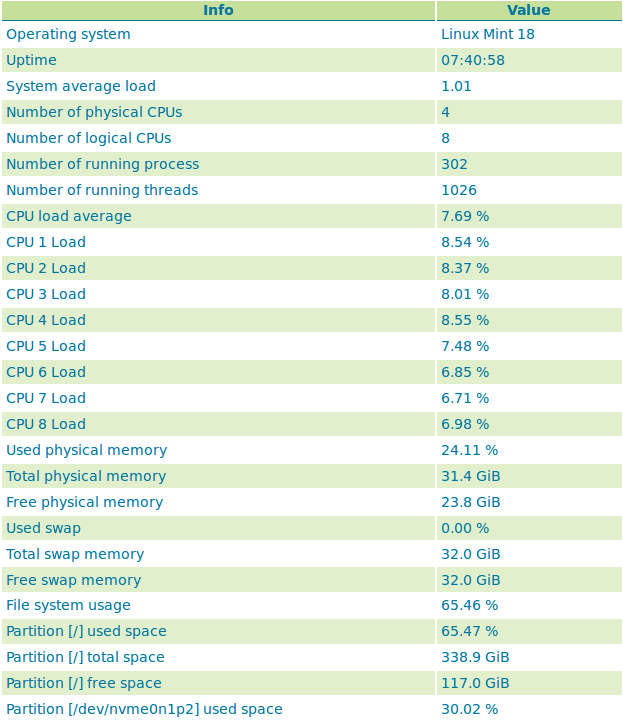About¶
The REST API allows you to set and retrieve information about the server itself.
Note
Read the API reference for /about/manifests <manifests.yaml>__.
Retrieving component versions¶
Retrieve the versions of the main components: GeoServer, GeoTools, and GeoWebCache
Request
curl
curl -v -u admin:geoserver -XGET -H "Accept: text/xml"
http://localhost:8080/geoserver/rest/about/version.xml
Response
<about>
<resource name="GeoServer">
<Build-Timestamp>11-Dec-2012 17:55</Build-Timestamp>
<Git-Revision>e66f8da85521f73d0fd00b71331069a5f49f7865</Git-Revision>
<Version>2.3-SNAPSHOT</Version>
</resource>
<resource name="GeoTools">
<Build-Timestamp>04-Dec-2012 02:31</Build-Timestamp>
<Git-Revision>380a2b8545ee9221f1f2d38a4f10ef77a23bccae</Git-Revision>
<Version>9-SNAPSHOT</Version>
</resource>
<resource name="GeoWebCache">
<Git-Revision>2a534f91f6b99e5120a9eaa5db62df771dd01688</Git-Revision>
<Version>1.3-SNAPSHOT</Version>
</resource>
</about>
Retrieving manifests¶
Retrieve the full manifest and subsets of the manifest as known to the ClassLoader
Request
curl
curl -v -u admin:geoserver -XGET -H "Accept: text/xml"
http://localhost:8080/geoserver/rest/about/manifest.xml
Note
The result will be a very long list of manifest information. While this can be useful, it is often desirable to filter this list.
Retrieve manifests, filtered by resource name
Note
This example will retrieve only resources where the name attribute matches gwc-.*.
Request
curl
curl -v -u admin:geoserver -XGET -H "Accept: text/xml"
http://localhost:8080/geoserver/rest/about/manifest.xml?manifest=gwc-.*
Response
<about>
<resource name="gwc-2.3.0">
...
</resource>
<resource name="gwc-core-1.4.0">
...
</resource>
<resource name="gwc-diskquota-core-1.4.0">
...
</resource>
<resource name="gwc-diskquota-jdbc-1.4.0">
...
</resource>
<resource name="gwc-georss-1.4.0">
...
</resource>
<resource name="gwc-gmaps-1.4.0">
...
</resource>
<resource name="gwc-kml-1.4.0">
...
</resource>
<resource name="gwc-rest-1.4.0">
...
</resource>
<resource name="gwc-tms-1.4.0">
...
</resource>
<resource name="gwc-ve-1.4.0">
...
</resource>
<resource name="gwc-wms-1.4.0">
...
</resource>
<resource name="gwc-wmts-1.4.0">
...
</resource>
</about>
Retrieve manifests, filtered by resource property
Note
This example will retrieve only resources with a property equal to GeoServerModule.
Request
curl
curl -u admin:geoserver -XGET -H "Accept: text/xml"
http://localhost:8080/geoserver/rest/about/manifest.xml?key=GeoServerModule
Response
<about>
<resource name="control-flow-2.3.0">
<GeoServerModule>extension</GeoServerModule>
...
</resource>
...
<resource name="wms-2.3.0">
<GeoServerModule>core</GeoServerModule>
...
</resource>
</about>
Retrieve manifests, filtered by both resource name and property
Note
This example will retrieve only resources where a property with named GeoServerModule has a value equal to extension.
Request
curl
curl -u admin:geoserver -XGET -H "Accept: text/xml"
http://localhost:8080/geoserver/rest/about/manifest.xml?key=GeoServerModule&value=extension
System Status¶
It is possible to request the available system information (monitoring data) through the GeoServer REST API. The supported formats are XML, JSON and HTML.
The available REST endpoints are:
/geoserver/rest/about/system-status
/geoserver/rest/about/system-status.json
/geoserver/rest/about/system-status.xml
/geoserver/rest/about/system-status.html
The HTML representation of the system data is equal to the System status tab representation:

System status¶
The XML and JSON representations are quite similar. For each system information metric, the following attributes will be available:
Name |
Description |
name |
name of the metric |
available |
TRUE if the system information value is available |
description |
description of this system information |
unit |
unit of the system information, can be empty |
category |
category of this system information |
priority |
this value can be used to render the metrics in a predefined order |
identifier |
identifies the resource associated with the metric, e.g. file partition name |
Example of XML representation:
<metrics>
<metric>
<value>99614720</value>
<available>true</available>
<description>Partition [/dev/nvme0n1p2] total space</description>
<name>PARTITION_TOTAL</name>
<unit>bytes</unit>
<category>FILE_SYSTEM</category>
<identifier>/dev/nvme0n1p2</identifier>
<priority>507</priority>
</metric>
(...)
Example of JSON representation:
{
"metrics": {
"metric": [
{
"available": true,
"category": "FILE_SYSTEM",
"description": "Partition [/dev/nvme0n1p2] total space",
"identifier": "/dev/nvme0n1p2",
"name": "PARTITION_TOTAL",
"priority": 507,
"unit": "bytes",
"value": 99614720
},